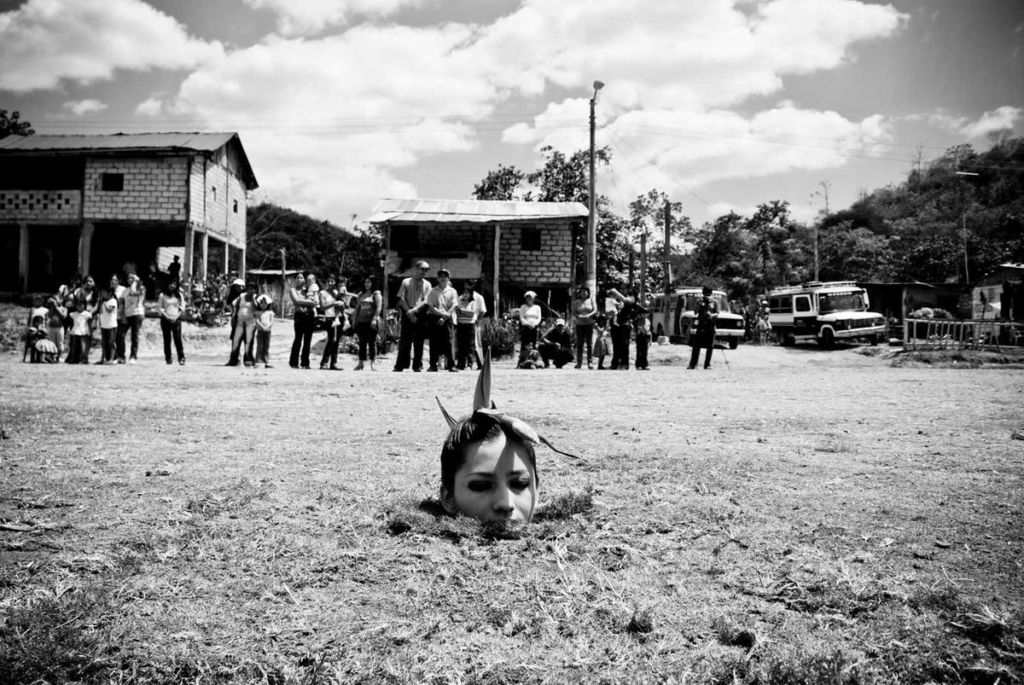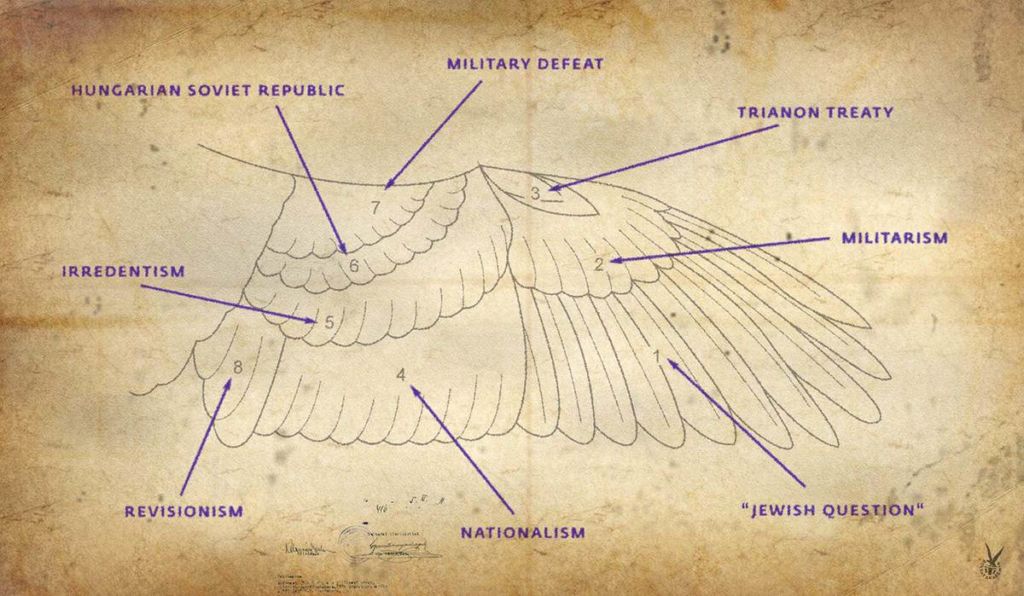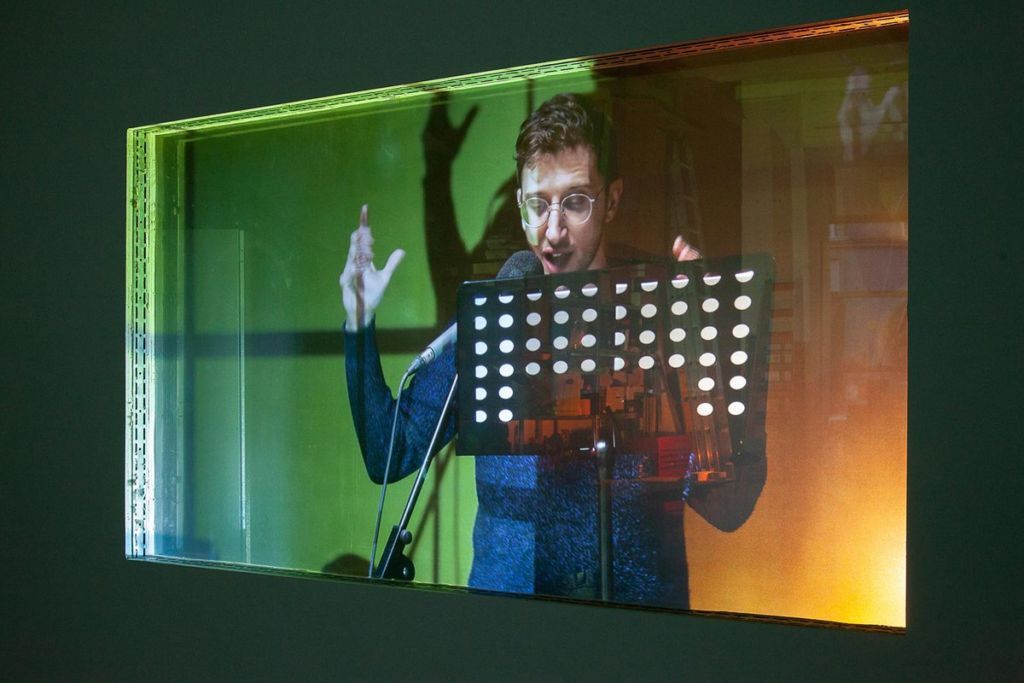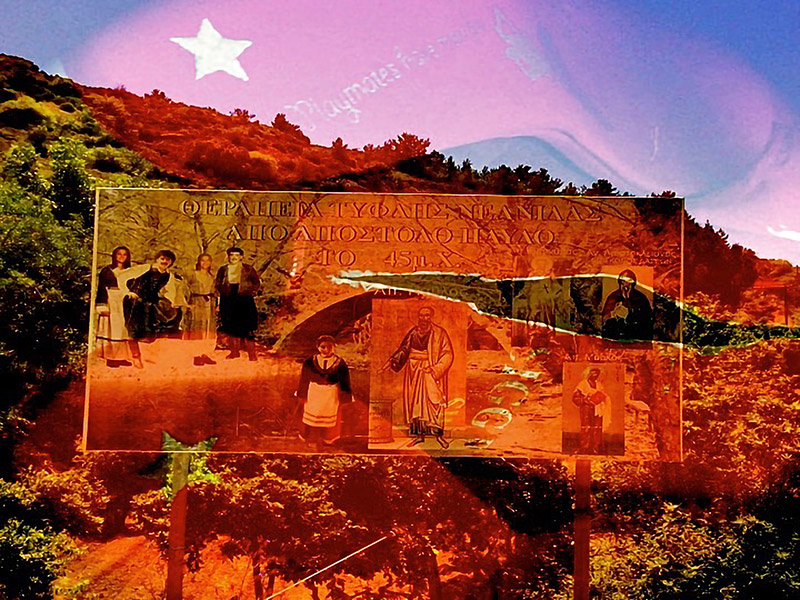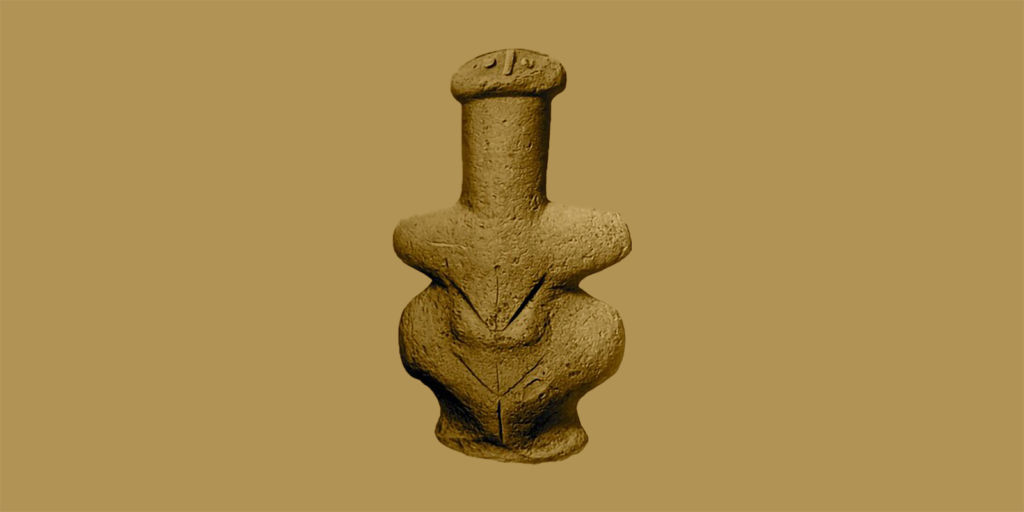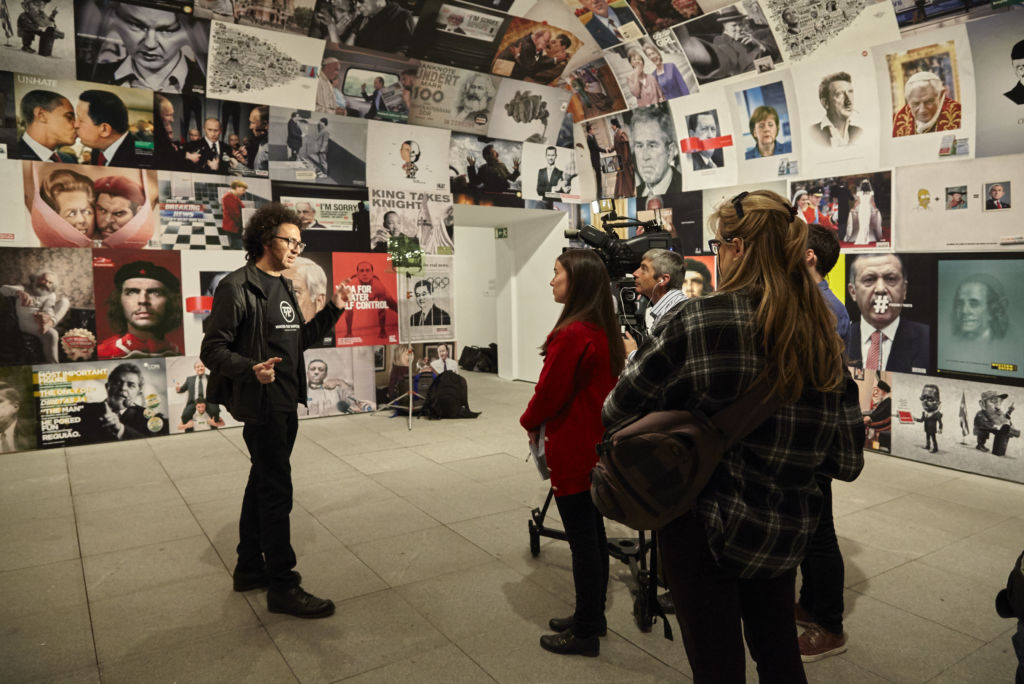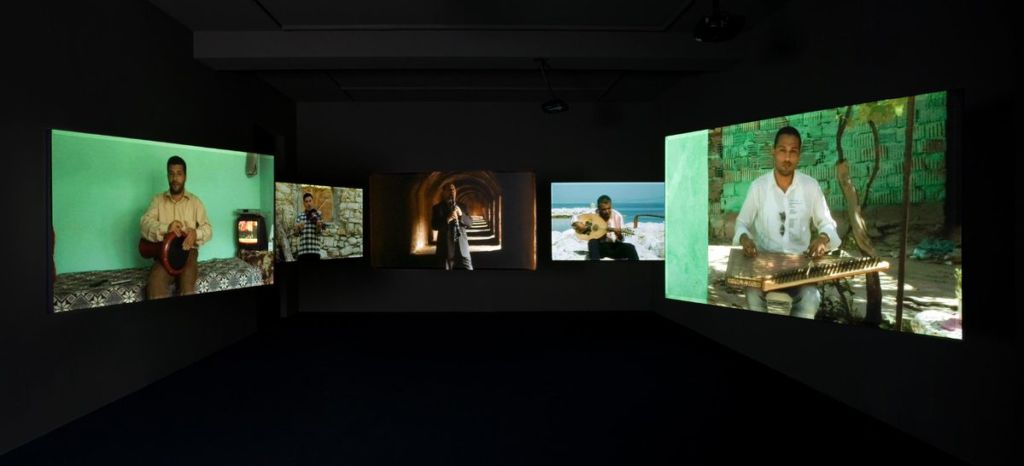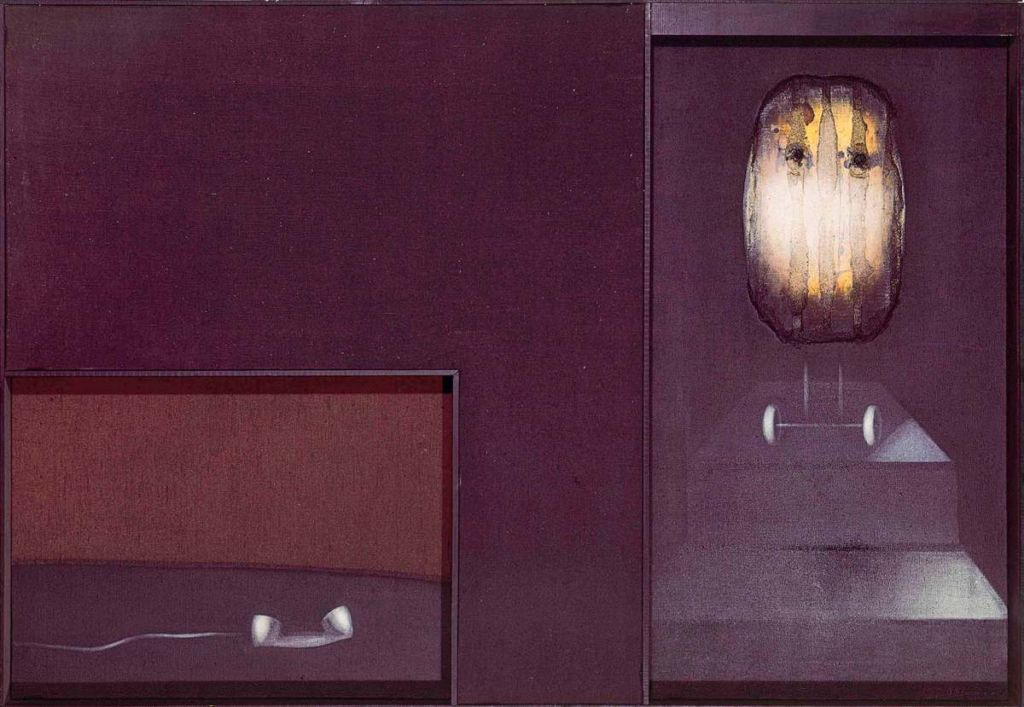Performance as Cannibal Delicacy in the Work of Saskia Calderón
Investigation by Amalina Bomnin Hernández
The work of Saskia Calderón, a performer trained in visual arts and lyric singing, is an atypical example of a proposal that destabilizes. She creates powerful comments on the sexist, racist, and xenophobic aspects of the Western paradigm of corporate mentality and extractive policies in Latin American countries. This article underlines the uniqueness of her work within a context that has been reluctant to make performance visible, due, among other factors, to the fragility of the Ecuadorian institutional system. Her situated artistic creations, thanks to the relevance and subtle methodology of her approach—like a cannibal delicacy—become civic artivism.
The concept of a “New Man” as described by Che Guevara, and embraced by the Left, is based on the educational and ideological formation of a citizen aligned with communism as the supreme possibility of social transformation.
Robert Louis Stevenson, South Sea Tales [1893], Chapter XI – Long-Pig – A Cannibal High Place: in Tahiti, “In historic times, when human oblation was made in the marae, the eyes of the victim were formally offered to the chief: a delicacy to the leading guest.” The Works of Robert Louis Stevenson, vol. 7 (Charlottesville: University of Virginia, 1907), 80.
José Assandri, Entre Bataille y Lacan: ensayo sobre el ojo, golosina caníbal (Between Bataille and Lacan: Essay on the eye, cannibal candy) (Buenos Aires: The silver bowl SRL, 2013), 43.
“C’est sous la forme des cathédrales et des palais que l’Eglise et l’Etat s’adressent et imposent silence aux multitudes. Il est evident, en effet, que les monuments inspirent la sagesse sociale et souvent même une veritable crainte. . . . Aussi bien, chaque fois que la composition architecturale se retrouve ailleurs que dans les monuments, que ce soit dans la phsyiognomie, le costume, la musique ou la peinture, peut-on inférer un goût prédominant de l’autorité humaine ou divine.” Georges Bataille, Dictionnaire critique de la revue Documents, no. 2 (May 1929). Translated by Madeleine Compagnon.
Including performance art, Happenings, interventions, video performance, among others, all part of Action art. Living WebSite: When attitudes become performances, University of the Arts, Guayaquil, Ecuador, April 2019: Antena Bomnin.
Georges Bataille, “La mutilation sacrificielle et l’oreille coupée de Vincent Van Gogh,” in Oeuvres complètes, vol. 1 (Paris: Gallimard, 1970), 263. Translated by Madeleine Compagnon.
Compositions by Fanny Mendelssohn (1805–1847), for example, called “the silenced sister” because, despite having composed around 470 pieces of music, the glory went to her brother Felix, in whose name many of the compositions appeared, thanks to the limited freedoms that women had; and a composition by Geminiano Giacomelli (1692–1740) written for a castrato, since women were banned from careers as opera singers.
Valeriano Bozal, Mímesis: las imágenes y las cosas (Madrid: Ediciones Antonio Machado, Colección La balsa de la Medusa, 1987), 70.
Jean-Luc Nancy, Listening, trans. Charlotte Mandell (New York: Fordham University Press, 2007), 3.
Georges Bataille, Theory of Religion [1973], trans. Robert Hurley (New York: Zone Books, 1989), 22.
Ibid.
Claude Lévi-Strauss, Tristes Tropiques [1955], trans. Doreen Weightman, John Weightman (New York: Penguin Book, 2012), 153.
Ibid.
Nancy, Listening, 29.
Ibid.
Joan Baumberger, “The Myth of Matriarchy: Why Men Rule in Primitive Society,” in Michelle Zimbalist Rosaldo and Louise Lamphere, eds., Women, Culture, and Society (Stanford: Stanford University Press, 1974).
Silvia Federici, Calibán and the witch: women, body and original accumulation (Buenos Aires: Tinta Limón Ediciones, 2018), 353.
Ibid.
Ocularcentrism vs. enucleation
Art in recent years has been thought of as Noah’s Ark, capable of saving the world from an impending flood, by those who believe in the importance of artistic pedagogies in the modulation of social processes; by the crestfallen Left, trying to protect the dream of a possible New Man1; by the Right and its scarce possibilities of popular redemption; by the owners of digital media, who manipulate our expectations of communication; and by the creative industries that engender inequality, taking more than they need. Gilles Lipovetsky pointed this out in his text, The Aestheticization of the World: Living in the Era of Artistic Capitalism, in which he comments on the popularization of creativity in all sectors: Establishing art as a means of salvation is inherently deceptive.
From Robert Louis Stevenson’s South Seas Tales of his excursion to the Pacific Islands in the late nineteenth century, emerges the term “cannibal delicacy,” referring to the search for food—specifically, the eyes of travelers—by the dead and their spirits2. Georges Bataille seized on this view of the eye, translated as “friandise cannibale,” as an object of seduction and horror to build new myths. The sliced eye evokes dread and fascination, pointing to the ambivalence of attraction or repulsion that Dalí and Buñuel emphasized in the most famous scene of their Andalusian Dog (Un Chien Andalou, 1929). As José Assandri suggests, perhaps it was the Surrealists’ goal, “at a time when the academic architecture of painting had disappeared, . . . to break the eye.”3 According to Bataille, “It is in the form of cathedrals and palaces that the Church and State speak to and impose silence on the multitudes. Monuments inspire fear and social wisdom, and at times even inspire fear. . . . Whenever architectural order is found anywhere other than in monuments, whether in physiognomy, dress, music, or painting, it is safe to assume a prevailing taste for human or divine authority.”4 He pointed out that it was necessary to question, to access an impartial vision.
Several myths related to blindness exist; the story of the Ancient Greek philosopher Democritus is one of the most radical. Deliberately blinding himself, in the belief that sight prevented him from seeing the true reality, Democritus comments on the gnoseological and perceptual emptiness he faced. Believing that sight—the mistakes eyes can make—could prevent him from observing the laws of nature clearly and precisely, Democritus turned blindness into a means of seeing. Other cases throughout history and mythology have equated blindness with intellectual and human fullness: look at Tiresias, Homer, and Jorge Luis Borges, whose sharpness of vision has been attributed to their blindness, understood as a critical sense, leading to a fuller understanding of the universe and greater empathy, without relying on vision.
I use the phrase coined by Georges Bataille, “cannibal delicacy,” to refer to how the exquisite images put forth by Ecuadorian performer Saskia Calderón (b. Quito, Ecuador, 1981) have the seductive capacity to attract the public and subtly introduce caustic comments. In this essay, her work is analyzed as an example of a deceptive proposal that uses traditional resources to disrupt colonial thought. The singularity of her work is emphasized in a context, that of her home country of Ecuador, that is reluctant to make performance visible, given, among other factors, the fragility of its institutional art system. Her work is articulated as a situated practice, due to the relevance and subtlety of her approach as civic artivism, merging art with activism. She addresses problems faced by the Ecuadorian and global society: the loss of original languages, the weight of patriarchy in culture, extractivism, gender violence, among others, and the public is involved in her work. To do this, she articulates a methodology that combines academic resources and others from social struggles.

Saskia Calderon, Requiem Huao, video-performance, 3 min, 2005 © Fundación El Comercio, Quito
Within the artistic discourse of recent years certain difficult, even apocalyptic, themes recur: femicide, queer approaches, the resurgence of nationalisms, environmental problems, neoliberal collapse. So many coinciding predictions of an imminent end could lead to a Manichean belief in the impossibility of positive change in the world order. But that view, implemented by neoliberal capitalism, must be considered with suspicion. The manipulation inherent in the cognitive and rationalist logic of our approach to the world (shaped by the mass media: the Internet, social networks, television) has brought about a functional illiteracy of serious dimensions.
Art made by women in Ecuador is very scarce; there is even less performance art, a genre with little exposure, due, among various factors, to a stale academic system and to institutional disinterest. I had the opportunity to meet Saskia Calderón in April 2019, when I invited her to Guayaquil to participate in an Action art festival that I curated under the title When Attitudes Become Performances.5 She presented her piece Melodic Dyspnea, which allowed me to see for myself the effectiveness of her approach to artmaking.
While reflections on violence, shock, or confrontation abound, it is rare, especially within Latin American performance art, to voice a discourse grounded in seduction. The two disciplines in which Saskia has trained—plastic arts and lyric singing—give her work a peculiar sense of beauty, resulting in the ideal combination to be read as “cannibal delicacy.”
Out of the darkness, to a situated “delicacy”

Saskia Calderon, Disnea melódica, performance, 12 min, 2019
Melodic Dyspnea, 2019, is the first performance by Calderón that I witnessed myself. Once the artist had arrived in Guayaquil to participate in When Attitudes Become Performances, I was able to notice certain characteristics of her physical presence that help explain why she stands out as a delicacy, and the conditions that allow for the development of her situated work: Calderón is slender, her face and body do not meet regional standards (local indigenous women are usually short, with dark skin and hair, while her hair is brown with lighter highlights, and her skin is pale). I mention this because Calderón works within a highly racist and classist context, in which women are a constant victim of femicides and their place in the art scene is marked by invisibility. Her work is atypical. Her stage presence, as she performs her lyric singing, is an important element to consider. Performance art as a genre has generally been associated with all kinds of provocations, ranging from tense rejection and disgust to ridicule, anguish, or pity. In Calderón’s case, performance generates a revival of Classicism that makes it the ideal target of the gaze, a delight that, in an indoctrinated (and biased) context like Ecuador, will encourage everyone, or almost everyone, to “devour.”
For Melodic Dyspnea the artist appeared dressed in white, with a black corset; her performance took place in an empty white room, with a laminated glass floor, which gave the scene fragility. She sang, in high-pitched tones, Article 66 of the Constitution of the Republic of Ecuador, which establishes individuals’ right to personal freedom, including a life without violence in the public and private spheres, and guarantees the adoption of measures necessary to prevent, eliminate, and punish all forms of violence. While singing, her corset limited her supply of oxygen, in a comment on the existence of laws that obstruct breath.
Bataille referred to “oedipal enucleation,” that is, to Oedipus’ radical act of gouging out his eyes as a renunciation of reality6. (Incidentally, in his biographical writings, Bataille mentions that his father was blind and paralyzed.) I mention this because in Retina Off, a performance/concert by Calderón from 2019, total darkness is imposed for the duration of the concert. The performers were a pianist, a baritone, and Calderón herself singing the soprano part, interpreting a selection of lyrical songs that were silenced by the patriarchy, from the pre-Hispanic period to the present.7 Going against the original classical myth of Oedipus, and its Freudian and even Lacanian interpretations, here the performance works from the reversal of roles. The original desire has changed, and a renunciation of the phallic appears (understood in this case as academic architecture: physiognomy, light, beauty, harmony, rhythm). In its place, the possible redemption of the feminine (the lyrical female voice) through the interruption of these taboo-bearing signs.
In the (true) beginning was the verb . . . and beyond the verb, the rite
There was a notion of mimesis, post-Homeric, prior to Aristotle and Plato, which defined the cathartic relationship established between the participants of the ritual in agrarian feasts, in which dance and song. Later, the West, from Greek antiquity, with the emergence of philosophical schools, translated the concept of mimesis as imitatio, referring to the mere imitative representation of nature. Mimesis was reduced to an immediate perceptive and creative, physical and sensitive experience, translatable into sensory, mechanical, and specular activity that obviously did not achieve a full emotional, cognitive, and spiritual dimension. Therefore, any association of the term with the mythical, the original, and the wild, was greatly reduced by modernity, which forged a system of aesthetic representation that boycotted the fundamental precepts of a real communion with the environment, as put into practice by ancient cultures.8 The mythological arché, or origin, of mimesis was not related to logical and rationalist concepts of space-time. Nor was it achieved through individual experiences, separate from the communitarian sense, and took place from perceptions that went beyond the ocular. The mimetic experience constituted the essence in the origins and passed through corporal expression, song, dance, rite, word, projected in an indissoluble triad between man, nature, and cosmos.
How modern man has distanced himself from myth is one of the topics addressed in Gallo Despescuezado (Flayed Rooster), 2008, a performance in which Calderón reinterprets a game popular in the community of Limoncito, a territory on the Ecuadorian Coast. During the celebrations of the Virgin of the Merced, a live rooster is buried in the ground up to its neck; and a villager, wearing a blindfold, tries to cut off its head with a machete. The victor gets to keep the dead rooster and provides another the following year. The artist, impressed by the ritual, decided to recreate it. She buried herself in a similar way to the animal, and sang about the problems and pressing needs of the inhabitants of Limoncito, whom she had previously interviewed. Her vehement interpretation of collective anguish permeated the audience. As philosopher Jean-Luc Nancy would ask, “Although it seems simple enough to evoke a form—even a vision—that is sonorous, under what conditions, by contrast, can one talk about a visual noise?”9
This artistic approach recalls the iconoclastic emblem of the secret society Achéphale, founded by Bataille, which he also used as a logo for his magazine: a drawing of a headless human body, in reference to the anarchy and chaos that the ideals of modernist progress had brought about:
The animal opens before me a depth that attracts me and is familiar to me. In a sense, I know this depth: it is my own. It is at the same time that which is farthest removed from me, that which deserves the name “depth,” which means precisely that which is unfathomable to me. But this too is poetry.10
Calderón would agree with Bataille’s conviction that the animal and the human are two worlds connected by “the sticky temptation of poetry,”11 poetry that distances it from the materiality of things, from humankind’s observations in exact sciences.
2014 was a year of consolidation in Calderón’s work, as can be seen in her works Vocal Technique and Opera Onowoca, which was awarded first prize at the twelfth Cuenca Biennial. She bases her work on the contrast established by Claude Lévi-Strauss in Tristes Tropiques between anthropoemia (from the Greek emein, ‘vomiting’) and anthropophagic practices, two strategies to confront the otherness of the other, which consists of eating and vomiting the enemy as a form of annihilation and exile. Lévi-Strauss argues that primitive societies “which regard the absorption of certain individuals possessing dangerous powers as the only means of neutralizing those powers and even of turning them to advantage.”12 He calls these societies anthropophagic, or cannibalistic. Anthropophagy is seen in the West as a symptom of barbarism, since it involves the consumption of human flesh, to neutralize and/or harness the strength and power of an adversary. Modern societies, in contrast, are bulimic, or anthropoemic: “ejecting dangerous individuals from the social body and keeping them temporarily or permanently in isolation, away from all contact with their fellows, in establishments specially intended for this purpose.”13
Calderón uses the act of vomiting as part of a ritual cleansing, to examine the difficult negotiation between nature and culture. Her performances combine this practice of antropoemia, used in native cultures as a source of cleansing energy, with the intonation of lyrical scales. Vomiting helps open the vocal cavity to produce a wide sound, and, in this case, aims to make visible the problematic spill of hydrocarbons in the Ecuadorian Amazon. The effectiveness of Calderón’s speech comes, following Nancy’s line of reasoning, from how “the phenomenal voice resonates (rhythmic pulsation, muscular contraction or relaxation, respiratory amplification, epidermal shiver . . . or everything we used to call, more or less confusedly, the manifestations of the ‘speaking body’)”14; something that painting, in its visual nature, fails to confer.
For her award-winning performance Ópera Onowoca, Calderón moved to the Amazon to transcribe the melodies heard in the jungle. In a real process of mimesis, she managed to capture vibrations, sounds, silences, and noises, which she performed through lyrical singing in a live performance. Later, the record of the action was projected in the same space. In it she evokes once again Nancy’s concepts of “pure resonance,” “the body as a resonance tube of the ultra-sense,” and the “subject as that which vibrates when listening.”15 They acquire a particular connotation in an opera conceived in collaboration with Huaoranís, Tagaeris, and Taromenanes spirits (of the people of the Ecuadorian Amazon Basin). The piece uses as a starting point a Huaorani worldview that blurs the distinction between the physical and spiritual worlds. Listening is activated to capture the presence of spirits from their ancestors in musical notes.
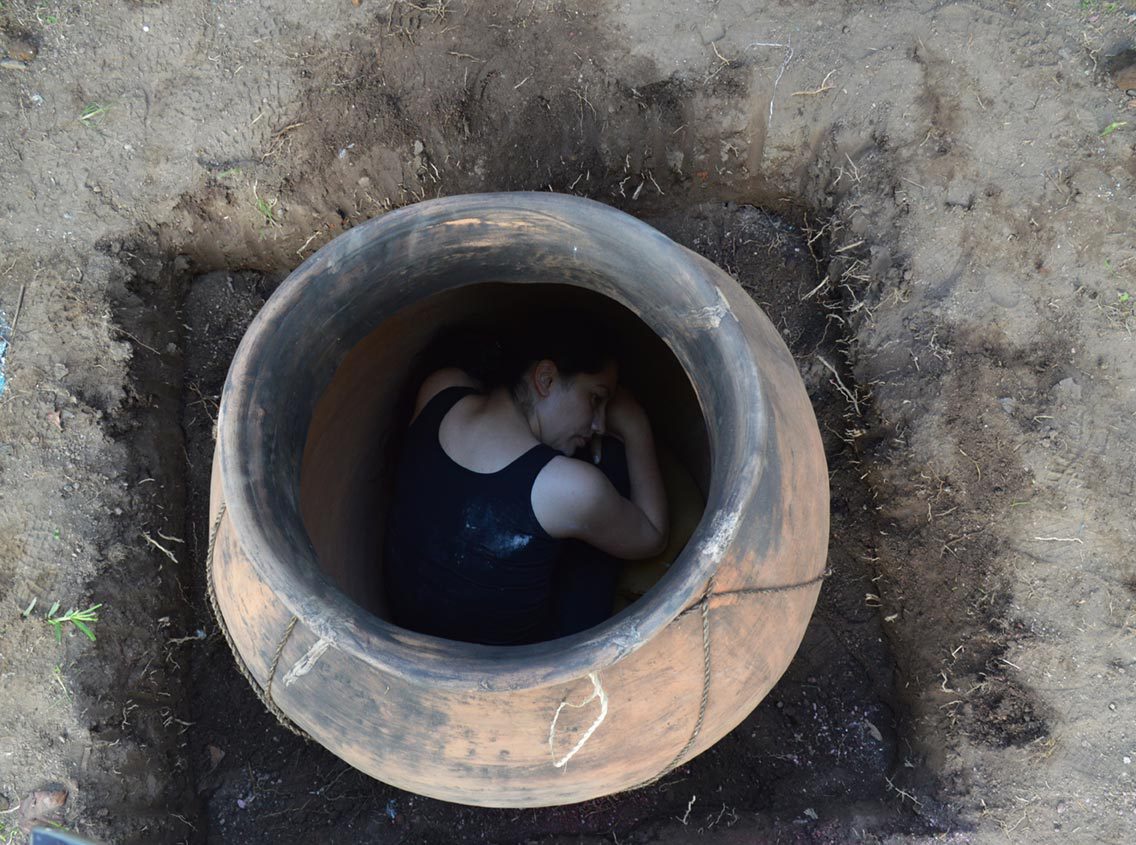
Saskia Calderon, Mater, performance, 15 min aprox, 2017 © Virginia Calderón
To mimic is to be
Once Calderón began her career in performance in 2003—she was barely 24 years old at the time—one of the pieces that attracted attention and attested to the maturity of her cultural concerns was the video-performance Requiem Huao. She painted her face with vegetable dyes and wore her hair in a manner characteristic of Huaorani women; to articulate aesthetic dissonances, she wore an industrially manufactured dress. Her interpretation of a lyrical funeral song, together with the architecture of the proposal, comments on the extinction of native languages and on the urgency of dealing with the voracious interference of the corporations extracting natural resources from ethnic and forest reserves.
In 2010, she presented Agudos Cº, a recital of songs in which she interpreted graphs of statistics of global temperature, according to the parameters of contemporary musical semiology. In public performance she emphasizes the high notes, melodically translating climate change and the increasing global warming of recent years.
Giving a piece a title that’s impossible to state out loud—the chemical formula for the hydrocarbon petroleum, used by Calderón as the title of a work in 2010—is a unique discursive strategy for an artist to adopt, one that subjects the act of speech to vision. Petroleum is irresponsibly extracted from the earth in various parts of the Amazon, and the government remains silent about the extraction of crude oil from the Ecuadorian jungle by transnational companies; the media participates in the concealment of a highly problematic topic. Calderón is interested in the Secoya ethnic group, to which indigenous groups from Peru and Ecuador belong. They conceive their own existence as an opportunity granted by the deity Ñañë, who can turn into the moon and is responsible for making them emerge from the bottom of the earth, with which they maintain sacred ties.

the chemical formula for the hydrocarbon petroleum, used by Calderón as the title of a work in 2010
By conceiving melodies with terms of the Tucaonan language, spoken by the Secoya, and the conversion into hertz of the numbers of the chemical components of oil, Calderón put together a piece that was accompanied by drawings of molecular structures. The language was mixed through a numerical system that she combined with the Latin alphabet. A whole framework of unknowns elaborated by the artist illustrates the arbitrariness implicit in colonial processes in imposing language, music, worldview, and customs. The urgency of putting an end to the loss and deterioration of a universe in which the earth (allegorized through the female body) is violated, in which ancestral voices are replaced by ill-advised economic policies, are some of the readings that this lyric interpretation raises about a region that is key to our future.
In a similar vein, her performance Mater, 2017, plays a role in vindicating ties with Mother Earth, this time commenting on the cultural manipulations imposed by colonial processes by denying or obliterating the matriarchal nature of humanity in its beginnings. All native cultures, not only American, but also African, Asian, and Eastern, share a belief in the cyclical nature of existence: birth-death-resurrection. The idea of sin, introduced by the West, somehow disrupts this cycle, since from this perspective, if the believer commits a sin, he will be punished, and will not enjoy eternal life. The price of sin has fallen on the female figure, responsible, from the Eurocentric point of view, for seducing man thoughtlessly to sin.
Singing in the fetal position, from inside a clay pot, Calderón recalled archaic burial rites. That ritual guarantees a new birth. Inside the pot she melodically interpreted texts by various anthropologists who mention the absence of matriarchy in the history of native peoples. To do so, she used vocalisms, exercises for the voice, with insistence on the vowels. In this case the performance linked voice, text, and music, and the pot served as a belly, uterus, matrix, establishing a parallel with the theme of matriarchy and its scientific treatment. Several texts related to this topic were interpreted lyrically. One of them was based on this statement by anthropologist Joan Bamberger: “The myth of matriarchy is but the tool used to keep woman bound to her place. To free her, we need it is necessary to destroy the myth.”16 The performance operates on the ambivalence between a minimized social organization, which some scientists have referred to as myth, trying to cancel its existence, and the possibility of an emerging matriarchy.

Saskia Calderon, Hydrocarbon, installation and performance, sounds, drawings and partitions, 20 min, 2016 © Virginia Calderón
Perform continuity
Dedicating oneself to activist art in Ecuador requires an extreme commitment. First, the crisis of the institutional system is such that, for example, anyone is likely to be legitimated, overnight, in newspapers or other media platforms, under the label of “curator,” without necessarily being one. On the other hand, the precariousness of cultural institutions—since they do not have economic autonomy—leads to the programming of exhibitions and events of the most diverse origins, which fail to configure a coherent, situated, and systematic curatorial profile.
It is easy to imagine that, within such circumstances, performance art leads to a loss. Generally, festivals, events, residencies and actions, related to the genre, take place through the initiative of a certain person or group, or thanks to the romantic spirit of researchers and managers interested in these practices. If we add to this that the Ecuadorian higher education system entails certain contractual limits that prevent the collaboration of performers with faculty, we are bound by a lack that hinders the learning and debate around the medium.
In a country that modernized with considerable delay (the first printing press arrived in Ambato in 1755 thanks to the Jesuit priest José María Maugeri; the first newspaper was published in 1884 in Guayaquil; the first theater constructed between 1879 and 1886), where the imprint of social realism in literature and indigenous nationalism in the visual arts have been promoted overseas as the languages of the national culture—at least from the institutional point of view—the challenge for Action art is really rigorous.
Add to the above the scope of the processes of colonial interference in Amerindian cultures. Customs such as cannibalism, sodomy, incest, and transvestism were “considered as evidence that the ‘Indians’ were the dominion of the Devil”17; however, popular medical practices in Europe between the sixteenth and eighteenth centuries included the consumption of human blood, water from mummies, and other preparations including various parts of the body, which were ingested by the rancid aristocracy. It was common, then, for epileptics to sample the blood of beheaded criminals, or victims of any other violent death, to find a cure for their ills. However, the metropolis opted, in American lands, from 1550 onward, to intensify the methods of social normalization through death.18
Under such conditions, an artistic practice that claims to be effective must consider political blindness as part of colonial vices. The fact that Calderón has successfully combined opera (it is worth noting that lyrical art is hardly appreciated in these parts) with Action art is part of its political effectiveness. The place of women in the artistic history of Ecuador contains extreme gaps; in a way, Calderón has managed to create a space for herself thanks to the delight that her interpretations arouse.
Bataille’s appropriation of the concept of “cannibal delicacy” contemplates, on the one hand, Stevenson’s externalized, anthropological gaze moved by the signs of premature death, and on the other, the ocular-centric bias of a culture bound, as Bataille put it, “by the prevailing taste for human or divine authority.” Calderón has activated this “trompe l’oeil.” To achieve this, an Ecuadorian artist must necessarily create the exquisite, a divine delicacy that many will be willing to taste.
Editor: Vincent Simon
Cover: Saskia Calderon, Gallo despescuezado, performance, 8 min, 2008 © Javier Lazo
